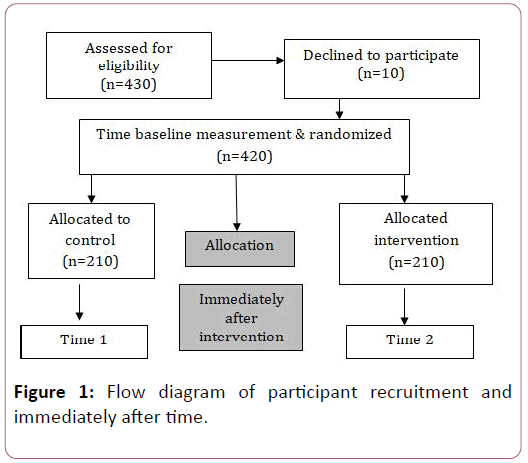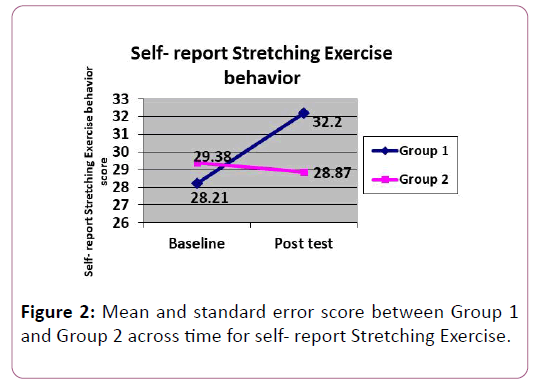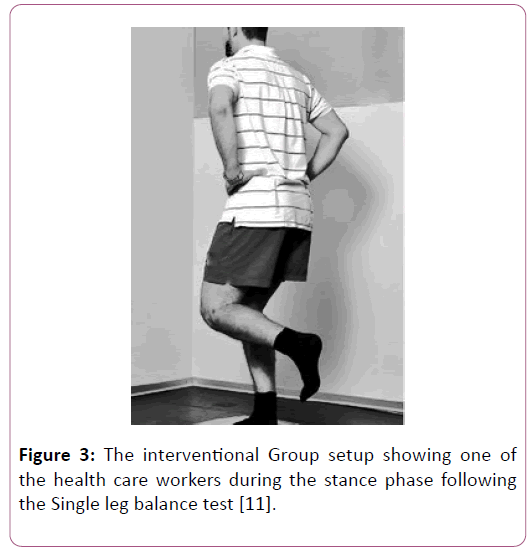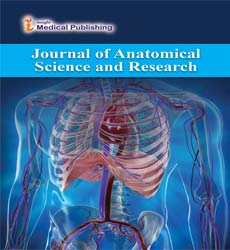The Effect of Static Workplace Stretching on the Balance in Computer Operators with a Single Leg Balance Test
Mohammad Hossein Delshad* and Fatemeh Pourhaji
Faculty of Medical Sciences, Tarbiat Modares University, Tehran, Iran
- *Corresponding Author:
- Mohammad Hossein Delshad
PhD Candidate of Health Education and Health Promotion Faculty of Medical Sciences
Tarbiat Modares University
Tehran, Iran
E-mail: H.Delshad@modares.ac.ir
Received date: October 04, 2018; Accepted date: November 14, 2018; Published date: November 21, 2018
Citation: Delshad MH, Pourhaji F (2018) The Effect of Static Workplace Stretching on the Balance in Computer Operators with a Single Leg Balance Test. J Anat Sci Res Vol. 1 No.2: 5
Copyright: © 2018 Delshad MH, et al. This is an open-access article distributed under the terms of the Creative Commons Attribution License, which permits unrestricted use, distribution, and reproduction in any medium, provided the original author and source are credited.
Abstract
Background: Flexibility is an essential component of the exercise program; however, it is not clear how the best use can be made in an educational program. It is common to spread stretching Exercise among computer operators. Stretching exercises are regularly recommended, even in many articles, with the goal of preventing injury and muscle pains, or even to increase muscle performance.
Objectives: The purpose of the present article is to determine static workplace stretching on the balance in computer operators with a Single leg balance test.
Patients and Methods: 420 health care workers with an average age of 37.1 (SD=8.03) who were randomly selected, were divided into two groups, with intervention and control group names. Within the intervention groups, individual differences in flexibility, familiarity with static stretching methods in teaching and doing stretching, and the distinction among the equilibrium test were considered. Initially, the pain test questionnaire (vas), then the stretching exercise (SE), and the Foot Balance Test, were performed before and after training based on the Pender Health Promotion Model (HPM). This period lasted for eight weeks, at some point of which period stretching was performed. Throughout this time, the software program was used to draw stretching sporting activities on the computer. Static test changed into was used to measure static equilibrium. Eventually, T-test was used for analysis.
Results: Significant increase in static balance after SE (37.1 ± 4.20) was observed. In contrast, before the SE (2.65 ± 3.87). Functional T-test analysis showed that there was a significant difference between intervention groups and control group (P<0.05). The intervention group was better than the control group and there was no significant difference in the control group. In the level of behavioral score, there was a significant difference between the two groups by independent t-test (P<0.001) and this was in the intervention group with the aid of paired t-test (P=0.222). VAS pain scores showed a significant difference between the two groups with independent t-test (P<0.001) and the VAS score in the intervention group was obtained by paired t-test (P<0.001).
Conclusions: SE with positive effects on pain relief, on the other hand, increased the behavior and static balance in computer operators with a single leg balance test.
Keywords
Postural balance; Health care workers; Health promotion; Stretching exercise
Introduction
Flexibility is an essential component of the exercise program; however, it is not clear how the best use can be made in an educational program [1]. This kind of exercise should be between the usual computer operators. Therefore, stretching exercises aimed at preventing injury and muscle pain and increasing the performance of exercises are recommended in many articles [2]. Reducing muscle strength is a risk factor for a life-threatening of death.
Prolonged sitting at the worksite causes musculoskeletal disorders. The most common effects of stretching in preventing musculoskeletal disorders among computer operators is to improve muscle performance [3]. Stretching Exercise is usually beneficial. For this Exercise, employees need to understand the musculoskeletal system, the cause and characteristics of skeletal muscle function. The US National Institutes of Health (NIH) and the National Cancer Institute (NIH) hade explained that skeletal muscle structures include many muscle fibers that blend together; Flexibility refers to the ability to stretch the muscles.
Before everyday work and during work activities. Office employers usually attend a low-level training program to help them get ready. Today, evidence suggests that stretching is not harmful. The main purpose of the stretching exercise is to enhance the performance of the sport through flexibility, strength, strength and endurance [4].
Several work-related factors have been identified to identify abnormalities. In addition, very unpleasant back pain (LBP) causes continuous neck and shoulder disorders and psychological stressors for the back, throat and shoulder, often consisting of: The back, throat, shoulder, forearm and hands. MSDs are common in many countries with significant costs and impacts on quality of life [5].
Posture control tests only play an important role in evaluating exercise performance. The balance screening method requires office employers to specifically assess the balance of single leg [6]. Static elasticity is believed to be flexible. Therefore, reducing muscle tension improves the risk of injury [7]. On the other hand, the features of this stretch method are easy, convenient and secure, which has been widely used throughout applications [8]. Therefore, the aim of the present study is to determine the local elasticity in static balance in computer operators with a Single leg balance test.
Methods
This research was a randomized controlled trial study (RCTs). In this method, there were two case and control groups. Within the intervention groups, individual differences in flexibility, familiarity with static stretching methods in teaching and doing stretching, and the distinction among the equilibrium test were considered.
Initially, the pain test questionnaire (vas), then the stretching exercise (SE), and the Foot Balance Test, were performed before and after training based on the Pender Health Promotion Model (HPM). This period lasted for eight weeks, at some point of which period stretching was performed. Throughout this time, the software program was used to draw stretching sporting activities on the computer.
Static test changed into was used to measure static balance. Eventually, firstly, with a familiarization meeting, all the issues involved with the implementation of the study were shared with the healthcare workers. Testing and completion of the questionnaire, the method of stretching, as well as the static balance test method to the implementation of training.
In the same population of 420 health care workers, only 24.5% of them were at the action stage of stretching and 21% were in the Maintenance phase stretching behavior. This means that more than 50% of them do not have the proper activity for stretching exercises [9]. The sample consisted of 420 Shahid Beheshti Medical Sciences healthcare workers (SHBUMS) in Tehran with a mean age of 37.1 (SD=8.03) and a multi-stage cluster sampling.
In the first stage, 10 health networks were selected using 420 locations in different geographical areas in SHBUMS, North, East, Shemiranat, and random networks of two health networks. Then, from two healthcare workers networks, eight health centers (210 health workers) were randomly selected.
After explaining the researchers about the goals and the process of testing, they were randomly divided into two groups: Intervention and control of 210 people (Figure 1) participated in this study. Initially, a pain test (Vas), training for stretching exercise strength was performed in accordance with Pender's Health Promotion Model and Single leg balance test. They were tested after 8 weeks of stretching exercise training in the intervention and control groups. Finally, T-test was used for analysis.
To assess and determine the static balance of individuals, the balance test was used for static balance examination in the previous study due to strong scientific and research justification (alpha=0.87). To test sting, it was done on the upper leg. While the non-superficial foam is superior to the inside of the leg, While the non-superior foam against the inside of the superior foot The subject will put his hands on his waist and up As much as possible, keeping that position on top of the upper shoulder stood. After taking the mentioned condition, simultaneously with the separation of the heel of the foot better than the ground, the time to stand on one leg up to the moment Collapse this situation using the stopwatch in seconds it was registered.
The time registration was continued until the subject tested the heel On top of it, he touched the floor, or the hands were separated from the waist. Or the lower leg was removed from the superior knee. In length perform a test, subject to a mark at a distance of 4 meters in front Her face was looking. Each subject has three attempts With a gap of 12 seconds, it took the best time Recorded as the subject rating [10].
Duration of Muscles stretched in the Group case 3 exercises (3 × 15 s) It was eight consecutive weeks. A static test was used to measure the static balance of subjects. Finally, was used T-test (independent/paired) for analysis.
Results
According to the study, Gasibat was performed [5]. The single leg balance test had been discussed. A significant increase in the static balance after TE (4.20 ± 1.37 s) vs TE (3.87 ± 2.65 s). However, in the control group, no improvement was observed in the single leg balance test.
After Without TE (3.87 ± 2.65 s) vs. compared to before (3.92 ± 6.08 s). Functional analysis showed that there was a significant difference between intervention group 1 and control group 2 (P<0.05). In the first group (intervention group), the mean ± standard deviation of the sport static balance test (pre-test: 18.21 ± 0.18), (post-test: 23.48 ± 2.78), the second group (control) means ± standard deviations of the static balance test Exercise (pre-test: 18.11 ± 2.14), (post-test: 19.03 ± 0.18). The intervention group was better than the control group, but the control group did not show differences between themselves (Table 1).
| Reference | Pre-test | Post-test | Type of stretching | Duration of Muscles stretched | Muscles tested | Action Results | |
|---|---|---|---|---|---|---|---|
| (sample size) | Group 1 | 18.21 ± 0.18 | 23.48 ± 2.78 | Static (active) | 3 exercises 3 × 15 s | Single leg balance test | 3.78 ± 4.40 s (1) |
| 4.20 ± 1.37 s (2) | |||||||
| Gasibat -420 | Group 2 | 18.11 ± 2.14 | 19.03 ± 0.18 | Static (passive) | Non | Single leg balance test | 3.92 ± 6.08 s (1) |
| 3.87 ± 2.65 s (2) | |||||||
| (1) Values are means ± standard deviations Tensioning Exercise, (2) Significant improvement over the pre score. | |||||||
Table 1: Compare the effects of tensioning exercise single leg balance methods.
At the end of training, a comparison was made between the two groups regarding the tensile training behavior. As a result of the behavioral score, there was a significant difference between the two groups in the independent test (P<.001). Behavior score in control group To help within groups paired ttest (P<.001) and Behavior score in intervention group To help Within groups paired t-test (P=.022) (Table 2 and Figure 2).
| Variable | Behavior score | p-value (a) | |
|---|---|---|---|
| Group 1 | Group 2 | ||
| Baseline | 28.21 ± 5.35 | 29.38 ± 0.10 | < 0.001 |
| Post test | 32.20 ± 3.55 | 28.87 ± 6.05 | < 0.001 |
| p-value (b) | <0.001 | 0.22 | |
| Values are presented as mean ± standard deviation. (a) Between groups, independent t -test; (b) within groups paired t -test. | |||
Table 2: Compare of the two groups regarding stretching exercise behavior at baseline and post-test.
Compare of two groups regarding pain intensity at baseline and post. The results of Pain intensity (VAS score) showed a no significant difference between the between two groups Baseline to help independent t-test (P=0.032) and significant difference between the between two groups Post-test to help independent t-test (P<.001). VAS score in control group to help within groups paired t-test (P =0.34) and VAS score in intervention group to help within groups paired t-test (P<.001) (Table 3 and Figure 3).
| Variable Pain intensity (VAS score) | S score | p-value (a) | |
|---|---|---|---|
| Group 1 | Group 2 | ||
| Baseline | 5.51 ± 1.97 | 5.20 ± 2.28 | 0.032 |
| Post test | 4.02 ± 2.53 | 5.11 ± 2.08 | <0.001 |
| p-value (b) | <0.001 | 0.34 | |
| Values are presented as mean ± standard deviation. (a) Between groups, independent t -test; (b) within groups paired t -test. | |||
Table 3: Compare of two groups regarding pain intensity before and after.
Figure 3: The interventional Group setup showing one of the health care workers during the stance phase following the Single leg balance test [11].
Discussion
There have not been many studies that demonstrate which stretching technique works best in helping to prevent pain Like Gregory study and Lempke study [12,13]. In the Razeghi study, Statistically significant improvements were measured for modified Exercise in eight directions of Muscles tested [14].
Despite the wide acceptance and use Stretching exercises as a prelude to sports exercises, There is limited research on the benefits Includes regular (e.g. daily, or two or three times per Week) drag to an educational program. This is especially true just about the benefits of doing Stretching exercises without any further educational qualifications. As noted above, previous research shows that the main advantage of regular stretching is unique it increases the range of motion, increases power.
Unfortunately, although power gains are associated with it Performance gains, this correlation do not require a direct Cause and Effect. In addition, stretching activities usually recommended. Included in training programs less than what is used to achieve it Power gains are shown in the studies above. Hence, this study is to determine if a regular pull program can improve multiple programs from the aspects of physical performance.
The results of this study show that 30 minutes of static stretching three times each Week for 8 weeks Increased flexibility in the organs of the body. So, the results of this Study of the insertion of stretching activities in Educational programs for non-educated or entertaining subjects.
Our finding that of static stretching has the capacity to improve flexibility is novel. After 15 days of static stretching hamstrings, Worrell et al. reported increases in maximal voluntary isokinetic torque [2].
Studies that have been shown in the literature about stretching are mainly muscle strength changes only in stretching muscles. At the same time, recent studies have also been conducted on the effects of cross pulling [10,7,15].
A fatiguing exercise protocol, combined with a single-leg test, was evaluated to improve the possibility of examination Educational Effects or Rehabilitation Interventions [16]. The Ntoumanis study intervention included face-to-face workshops, video/information video tutorials, discussion and group activities, brainstorms, individual planning and practical work at the Cycling Studio.
Coaches and trainers responded to valid questionnaires on instructors' use of motivational strategies and other motivational variables before the first workshop and at the end of the third and final workshop (4 months later). Hand-tohand interactions had no significant effect, probably due to the loosening of teachers and athletes in the control arm [17].
It can be said that the duration of stretch in the Serefoglu study like this study is sufficient to obtain possible changes in muscle strength [18].
Among the 246 computer users at Sains Islam Malaysia University (USIM) in the Salihin Arshada study data Analyzed in the Statistical Package of the Social Sciences. Nordic The questionnaire showed that the prevalence of musculoskeletal disorders (MSDs) among Computer users, body regions of the neck (19.9%), upper back (19.5%), and shoulder (17.4%) respectively more than in other body regions.
Based on the results of ROSA, 77.2% of the computer workstations in the case study area were at medium. Similarly, the administrative staff in China was the most prevalent MSD on the neck [19]. This study, similar to the current study, showed that most of the problems are with the back, shoulder and neck users.
Baidilleh study suggests developing technologies in development such as automated implementation Computer cutting system and a pull-out reminder program on the computer apart from Have a redesigned workspace [20]. That's automatic Computer system and a schedule stretching reminder program on the computer apart from working space has been developed and implemented in the study.
In the Smith study [21], of the position of two sample participants with their report Complete chronic pain was performed independently by linear regressions for each one and significant differences were observed between the intervention and control groups As in the present study VAS score in the interventiongroup (P<.001).
In the study, Josefsson found significant interfering effects Activity level and quality of motivation and behavior. Also the impact of intervention regarding the quality of motivation in exercise, its average scores increase and the rules have been identified.
The results of the presentation are interesting About the mechanisms involved in Exercise Change behavior [22]. The current study of Behavior score showed a significant difference between two groups t-test (P<.001). In Josephson study clearly, support, independence, structure, and participation have been discussed. Because physical activity and exercise behavior are suggested
For multi-dimensional behaviors that are difficult to cover With a particular theory [22]. Exergaming presented a new method for increasing or replacing physical activity in the short term [23]. In the present study, we also want to show new educational methods, such as trash-stretching reminder software (pop-up) for computer users in the busy world. Hope our efforts can reduce a small number of problems in the community.
Conclusion
Stretching exercises are effective and has beneficial effects on Pain reduction function, increased behavior and static balance in computer operators with a Single leg balance test.
Limitations
Our research has limitations. At first, the study was performed on a cross-sectional and each variable was measured one once, except for Single leg balance test. Exposure and outcome were measured simultaneously, and this prevented the detection of causal relationships. Second, the study was based on self-reported data; which may be some wrong data collected and analyzed in this research may be due to the neglect of the reminder.
Acknowledgements
The authors feel the need to thank all the participants and researchers who assisted them along the course of the study. The authors would like to thank research deputy of SHBUMS University (HSR) for its financial support of this study.
Finance/Disclosure
None declared.
Proclamation of Penchant
The authors acclaimed that they have no rivaling interests.
Author Contribution
M H D, FP: Conducted whole study and had full access to all of the data for analysis. Also she was involved in drafting the article
M H D, FP: Evaluation and verification of their eligibility for the study of office workers. He took responsibility for conducting the study and the integrity of the data and the accuracy of the data collection.
M H D, FP: Partnership in this study, all authors’ confirmation the final
References
- Gill, Williams, Reifsteck (2017) Psychological dynamics of sport and exercise. Human Kinetics (4th-edition)- 352
- Baxter, Mc Naughton, Sparks, Norton, Bentley (2017) Impact of stretching on the performance and injury risk of long-distance runners. Res Sports Med 25: 78-90
- Delshad, Tavafian, Kazemnejad (2016) Prevention of workplace musculoskeletal disorders among computer operators. Health Education & Health Promotion 4: 1-3.
- Klein (2017) The effects of a proper warm up in the prevention of musculoskeletal strains in collegiate female field hockey athletes. Goucher
- Gasibat, Simbak, Aziz, Petridis, Tróznai, et al. (2017) Stretching exercises to prevent work-related musculoskeletal disorders-a review article. American Journal of Sports Science and Medicine 5: 27-37.
- Talarico, Lynall, Mauntel, Weinhold, Padua (2017) Static and dynamic single leg postural control performance during dual-task paradigms. J Sports Sci 35: 1118-1124.
- Garrett Jr, Faherty (2017) Muscle-tendon junction injury. Muscle and Tendon Injuries. Springer 40: 51-60.
- Kalichman, David (2017) Effect of self-myofascial release on myofascial pain, muscle flexibility, and strength: A narrative review. J Bodyw Mov Ther 21: 446-451.
- Delshad, Tavafian, Kazemnejad (2017) The status of tension exercise behavior among iranian office workers based on trans theoretical model. International Journal of Musculoskeletal Pain Prevention 2: 251-256.
- Curtolo, Tucci, Souza, Gonçalves, Lucato (2017) Balance and postural control in basketball players. Fisioterapia em Movimento 30: 319-328.
- Donath, Roth R, Hohn Y, Zahner L, Faude O (2014) Zumba Training improves cardiovascular and neuromuscular performance in young female college students. Medicine & Science in Sports & Exercise 46: 85.
- Lempke, Green, Murray, Stanek (2017) The effectiveness of PNF vs. static stretching on increasing hip flexion range of motion. J Sport Rehabil 27: 289-294.
- Walsh (2017) Effect of static and dynamic muscle stretching as part of warm up procedures on knee joint proprioception and strength. Hum Mov Sci 55: 189-195.
- Razeghi, Hamoule (2017) Comparison of the immediate effects of modified and routine warm-ups on knee joint function and dynamic balance in athletes. Journal of Rehabilitation Sciences and Research 3: 97-102.
- Rodrigues, Rabelo, Couto, Motta-Santos, Drummond (2017) Acute effects of single bout of stretching exercise and mechanical vibration in hamstring muscle. Journal of Exercise Physiology Online 4 : 46-57
- Augustsson, Thomee, Linden, Folkesson, Tranberg (2006) Singleâ€ÂÂleg hop testing following fatiguing exercise: Reliability and biomechanical analysis. Scandinavian journal of medicine & science in sports 16: 111-120.
- Ntoumanis, Thøgersenâ€ÂÂNtoumani, Quested, Hancox (2017) The effects of training group exercise class instructors to adopt a motivationally adaptive communication style. Scandinavian journal of medicine & science in sports 27: 1026-1034.
- Serefoglu, Sekir, Gür, Akova (2017) Effects of static and dynamic stretching on the isokinetic peak torques and electromyographic activities of the antagonist muscles. Journal of sports science & medicine 16: 6-13
- Arshada, Mohd (2017) Evaluation of musculoskeletal disorders among computer users. Iranian Journal Of Health, Safety And Environment 2: 33.
- Baidilleh, Sarip (2017) Prevalence of computer visual syndrome among employee in malaysian software testing board. In Symposium on Occupational Safety & Health 20: 56.
- Smith, Jensen, Kitt, Koch (2017) Comparing the assay sensitivity of average pain intensity and worst pain intensity: An acttion meta-analysis. The Journal of Pain 19: 953-960
- Weman-Josefsson, Fröberg, Karlsson, Lindwall (2017) Mechanisms in self-determined exercise motivation: Effects of a theory informed pilot intervention. Current Psychology 36 : 90-100.
- Papastergiou (2009) Exploring the potential of computer and video games for health and physical education: A literature review. Computers & Education 53: 603-622.
Open Access Journals
- Aquaculture & Veterinary Science
- Chemistry & Chemical Sciences
- Clinical Sciences
- Engineering
- General Science
- Genetics & Molecular Biology
- Health Care & Nursing
- Immunology & Microbiology
- Materials Science
- Mathematics & Physics
- Medical Sciences
- Neurology & Psychiatry
- Oncology & Cancer Science
- Pharmaceutical Sciences



